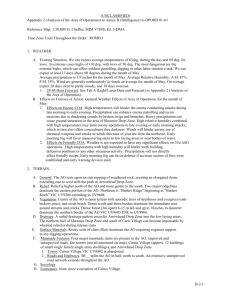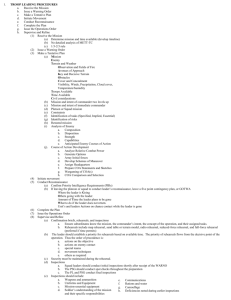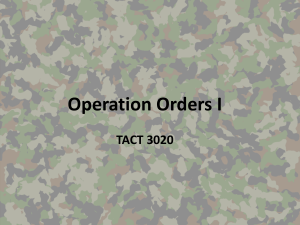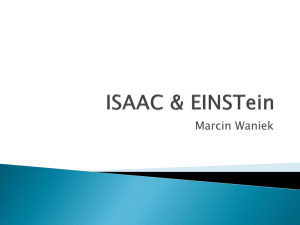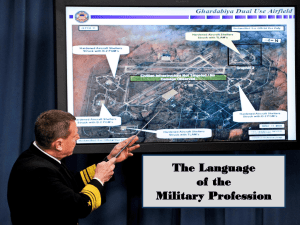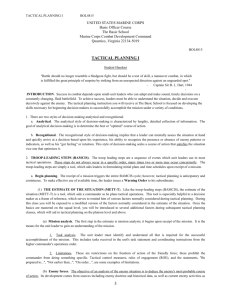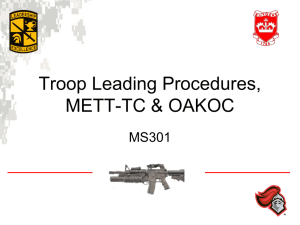CHAPTER FIVE
advertisement
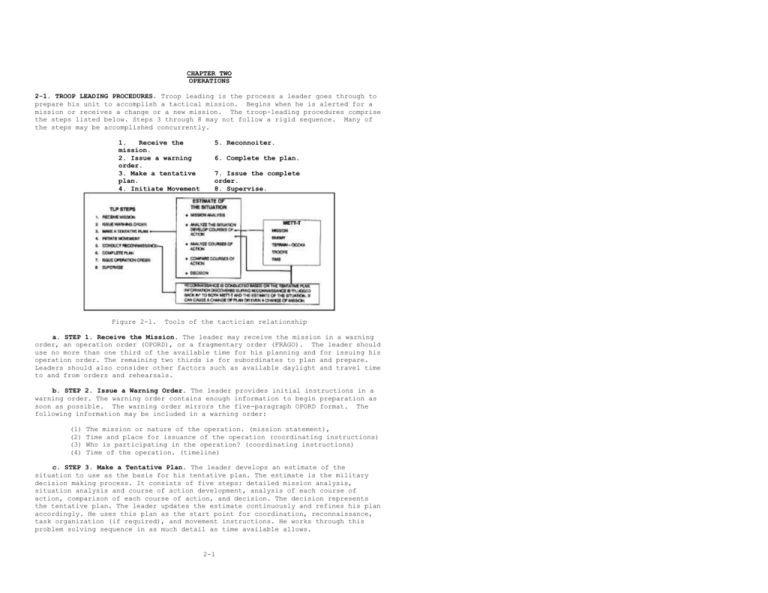
CHAPTER TWO OPERATIONS 2-1. TROOP LEADING PROCEDURES. Troop leading is the process a leader goes through to prepare his unit to accomplish a tactical mission. Begins when he is alerted for a mission or receives a change or a new mission. The troop-leading procedures comprise the steps listed below. Steps 3 through 8 may not follow a rigid sequence. Many of the steps may be accomplished concurrently. 1. Receive the mission. 2. Issue a warning order. 3. Make a tentative plan. 4. Initiate Movement Figure 2-1. 5. Reconnoiter. 6. Complete the plan. 7. Issue the complete order. 8. Supervise. Tools of the tactician relationship a. STEP 1. Receive the Mission. The leader may receive the mission in a warning order, an operation order (OPORD), or a fragmentary order (FRAGO). The leader should use no more than one third of the available time for his planning and for issuing his operation order. The remaining two thirds is for subordinates to plan and prepare. Leaders should also consider other factors such as available daylight and travel time to and from orders and rehearsals. b. STEP 2. Issue a Warning Order. The leader provides initial instructions in a warning order. The warning order contains enough information to begin preparation as soon as possible. The warning order mirrors the five-paragraph OPORD format. The following information may be included in a warning order: (1) (2) (3) (4) The mission or nature of the operation. (mission statement), Time and place for issuance of the operation (coordinating instructions) Who is participating in the operation? (coordinating instructions) Time of the operation. (timeline) c. STEP 3. Make a Tentative Plan. The leader develops an estimate of the situation to use as the basis for his tentative plan. The estimate is the military decision making process. It consists of five steps: detailed mission analysis, situation analysis and course of action development, analysis of each course of action, comparison of each course of action, and decision. The decision represents the tentative plan. The leader updates the estimate continuously and refines his plan accordingly. He uses this plan as the start point for coordination, reconnaissance, task organization (if required), and movement instructions. He works through this problem solving sequence in as much detail as time available allows. 2-1 The leader develops an estimate of the situation to use as the basis for his tentative plan. The estimate has five steps. (1) Conduct a detailed mission analysis. (a) The Higher Commanders' Concept and intent two levels up. This information is found in paragraph 1b for two levels up and in paragraphs 2 and 3 for one higher. (b) The Unit's Tasks. Tasks that are clearly stated in the order (Specified Tasks) or tasks that become apparent as the OPORD is analyzed (Implied Tasks). 1. Examples of specified tasks are: a. Retain hill 545 to prevent envelopment of B Co. b. Provide one squad to the 81-mm platoon to carry ammo. c. Establish an OP VIC GL124325 NLT 301500 NOV 89. 2. Examples of implied tasks are: a. Provide security during movement. b. Conduct resupply operations. c. Coordinate with adjacent units. (c) The Unit's Limitations. The leader next determines all control measures or instructions in the OPORD that restrict his freedom of action; these are called limitations. In every operation, there are some limitations on the unit. The following are some examples of common limitations: 1. 2. 3. 4. Graphic control measures. Cross the LD at 100030 OCT 94. MOPP4 in effect. Weapons status, tight; warning status, yellow. (d) Mission-Essential Task(s). After reviewing all the above factors, the leader identifies his mission-essential task(s). Failure to accomplish a missionessential task results in the unit's failure to accomplish its primary purpose for that operation. The mission essential task should be found in the maneuver paragraph. (e) The Restated Mission Statement. The restated mission statement becomes the focus for the remainder of the estimate process. This is a clear, concise statement of the mission essential task(s) to be accomplished by the unit and the purpose to be achieved. The mission statement will state WHO, WHAT (the task), WHEN (the critical time), WHERE (usually a grid coordinate), and WHY (the purpose the unit must achieve). Some examples of restated missions follow: 1. (WHO) 1st Platoon attacks (WHAT) to seize (WHERE) HILL 482 VIC NB 457371 (OBJ BLUE) (WHEN) NLT 09050OZ Dec 92 L 482 (OBJ BLUE) (WHY) to enable the company's main effort to destroy enemy command bunker. 2. (WHO) 1st Platoon, C Company defends (WHAT) to destroy from (WHERE) AB163456 to AB163486 to AB123486 to AB123456 (WHEN) NLT 28153OZ Oct 97 (WHY) to prevent enemy forces from enveloping B Company, 1-66 infantry (L) from the south. (2) Analyze the situation and develop a course of action. (a) Each COA must be: 1. Feasible: It accomplishes the mission and supports the commander’s concept. 2. Reasonable: The unit remains an effective force after completing the mission. 2-2 3. Distinguishable: It is not just a minor variation of another COA. (b) Upon developing a COA, the unit leader will assign C2 headquarters, complete generic task organization assigning all organic and attached elements, and prepare COA statement and sketch. (c) With the restated mission from step one to provide focus the leader continues the estimate process using the remaining factors of METT-TC: 1. Mission. The leader considers his mission as given to him by his commander. He analyzes it in light of the commander's intent two command levels higher, and derives the essential tasks his unit must perform in order to accomplish the mission. 2. Enemy. The leader considers the type, size, organization, tactics, and equipment of the enemy he expects to encounter. He identifies their greatest threat to his mission find their greatest vulnerability. What is known about the ENEMY? a. Composition. This is an analysis of the forces and weapons that the enemy can bring to bear. Determine what weapons systems they have available, and what additional weapons and units are supporting him. b. Disposition. The enemy's disposition is how he is arrayed on the terrain, such as in defensive positions, in an assembly area, or moving in march formation. c. Strength. Percentage strength. d. Recent Activities. Identify recent and significant enemy activities that may indicate future intentions. e. Reinforcement Capabilities. Determine positions for reserves and estimated time to counterattack or reinforce. f. Possible Courses of Actions. Determine the enemy's possible COAS. Analyzing these COAs may ensure that the friendly unit is not surprised during execution. 3. Terrain. The leader considers the effect of terrain and weather on enemy and friendly forces using the guidelines below (OCOKA). In considering the effects of weather, the mot significant aspects are visibility, trafficability, and survivability. a. Obstacles. In the attack, the leader considers the effect of restrictive terrain on his ability to maneuver. In the defense, he considers how he will tie in his obstacles to the terrain to disrupt, turn, fix, or block an enemy force and protect his own forces from enemy assault. b. Cover and concealment. Look for terrain that will protect from direct and indirect fires (cover) and from aerial and ground observation (concealment). Weapon positions must have both to be effective and to be survivable. Infantry units are capable of improving poor cover and concealment by digging in and camouflaging their positions. When moving, the terrain is used to provide cover and concealment. c. Observation and fields of fire. Determine locations that provide the best observation and fields of fire along the approaches, near the objective, or on key terrain. The analysis of fields of fire is mainly concerned with the ability to cover the terrain with direct fire. Fields of fire in terms of the characteristics of the weapons available; for example, maximum effective range, the requirement for grazing fire, and the arming range and time of flight for antiarmor weapons. d. Key terrain. Key terrain is any locality or area whose seizure, retention or control affords a marked advantage to either combatant. 2-3 Consider key terrain in selection of objectives, support positions, and routes in the offense, and on the positioning of the unit in the defense. Look for key terrain that dominates avenues of approach or the objective area and for decisive terrain that if held or controlled will have an extraordinary impact on the mission. e. Avenues of approach. An avenue of approach is an aerial, surface, or subterranean route of an attacking force of a given size leading to its objective or key terrain in its path. In the offense, identify the avenue of approach that affords the greatest protection and places the unit at the enemy’s most vulnerable spot. In the defense, the position weapons along the avenue of approach most likely to be used by the enemy. 1. Offensive considerations include; How can these avenues support my movement? What are the advantages/disadvantages of each? (Consider enemy, speed, cover, and concealment.) What are the likely enemy counterattack routes? 2. Defensive considerations include; How can the enemy use these approaches? Which avenue is most dangerous? Least? (Prioritize each approach.) Which avenues would support a counterattack? 4. Troops available. Consider the strength of subordinate units, the characteristics of his weapon systems, and the capabilities of attached elements as tasks are assigned to subordinate units. 5. Time available. Refines the allocation of time based on the tentative plan and any changes to the situation. 6. Civilians. Considers the impact of civilians in the area of operation and how they might affect the mission. (3) Analyze courses of action (Wargame). This analysis is conducted by wargaming the friendly courses of action against the enemy's most probable courses of action. (4) Compare courses of action. Compares the COAs and select the one that is most likely to accomplish the assigned mission. Considers the advantages and disadvantages for each COA and how the critical events impact on COAs. (5) Make a decision. Selects the COA that has the best chance of accomplishing the mission. d. STEP 4. Start Necessary Movement. The unit may need to begin movement while the leader is still planning or forward reconnoitering. This step could occur at any time during the troop-leading procedure. e. STEP 5. Reconnoiter. If time allows, the leader makes a personal reconnaissance. When time does not allow, the leader must make a map reconnaissance. Sometimes the leader must rely on others (for example, scouts) to conduct the reconnaissance. f. STEP 6. Complete the Plan. Completes the plan based on the reconnaissance and any changes in the situation. g. STEP 7. Issue the Complete Order. CDR normally issues oral operations orders to aid subordinates in understanding the concept for the mission. If possible, leaders should issue the order with one or both of the following aides: (1) Within sight of the objective (2) On a terrain model or sketch. all of part of the order or demonstrate on the operation. They should also quiz their understand the mission. or on the defensive terrain Leaders may require subordinates to repeat the model or sketch their understanding of soldiers to ensure that all soldiers 2-4 h. STEP 8. Supervise. The leader supervises the unit's preparation for combat by conducting rehearsals and inspections. (1) The leader uses rehearsals to-(a) Practice essential tasks (improve performance). (b) Reveal weaknesses or problems in the plan. (c) Coordinate the actions of subordinate elements. (d) Improve soldier understanding of the concept of the operation (foster confidence in soldiers). (2) Rehearsals include the practice of having Section Commanders brief their planned actions in execution sequence to the platoon leader. The leader should conduct rehearsals on terrain that resembles the actual ground, and in similar light conditions. The platoon may begin rehearsals of battle drills and other SOP items before the receipt of the operation order. Once the order has been issued, it can rehearse mission specific tasks. Some important tasks to rehearse include-(a) (b) (c) (d) (e) (f) Actions on the objective. Assaulting a trench, bunker, or building. Actions at the assault position. Breaching obstacles (mine and wire). Using special weapons or demolitions. Actions on unexpected enemy contact. (3) Rehearsal Types (a) Back brief: Key leaders brief actions required during operation. The CDR controls the back brief. The mission is briefed sequentially (b) Reduced Force: Conducted when time is key constraint and/or when security must be maintained Key leaders normally attend. Use mock-ups, sand tables, and small scale replicas. (c) Full Force. The most effective type. First executed in daylight and open terrain and then in same conditions as operation. All soldiers participate and a technique is the use of force on force (4) Rehearsal Techniques (a) Force on Force (b) Map: Limited value and usually a limited number of attendees (c) Radio: Cannot mass leaders but confirms communications. (d) Sand table/terrain model: Key leaders are included at a minimum and includes all control measures (e) Rock drill: Similar to sand table/terrain model with subordinates actually moving themselves. (5) Inspections. Section Commanders should conduct initial inspections shortly after receipt of the warning order. The SGM spot checks throughout the unit's preparation for combat. The CDR and SGM make a final inspection. They should inspect: (a) Weapons and ammunition. (b) Uniforms and equipment. (c) Mission-essential equipment. (d) Soldier's understanding of the mission and their specific responsibilities. (e) Communications. (f) Rations and water. (g) Camouflage. 2-5 (h) Deficiencies noted during earlier inspections. 2-2. COMBAT INTELLIGENCE. Gathering information is one of the most important aspects of conducting patrolling operations. The following details what information to collect and how to report it. a. Reporting. All information must be quickly, completely, and accurately reported. Use the SALUTE report format for reporting and recording information. b. Field Sketching. When reporting information include a sketch, if possible. Limit the detail of the sketch to aspects of military importance such as targets, objectives, obstacles, sector limits, or troop dispositions and locations. The symbols used should be the standard Army symbols IAW FM 101-5-1. Notes should be used to explain the drawing, but they should not clutter the sketch. Personnel/weapons and/or equipment should not be used on the sketch, as it is a part of the “SALUTE” report. c. Captured Documents. Documents are collected by the leader and turned in when he makes his reports. The documents should be marked as to time and place of capture. d. Prisoners. If prisoners are captured during a patrolling operation, they should be treated IAW the Geneva Convention and handled by the 5-S rule: Search Silence Segregate Safeguard Speed to Rear e. Debriefing. Immediately upon return from a mission, the unit will be debriefed using the standard NATO report format. 2-3. WARNING ORDER. Warning orders give subordinates advance notice of operations that are to come. This gives them time to prepare. The order should be brief, but complete. A WARNING ORDER DOES NOT AUTHORIZE EXECUTION UNLESS SPECIFICALLY STATED. A sample annotated WARNORD format follows: Copy no ____ of ____ copies Issuing headquarters Place of issue Date-time group of signature Message reference number WARNORD __________ (code name) (Number) (Orders are normally numbered beginning with the year prepared followed by the sequential number of the order, i.e. an the 3rd order written in 1998 would be numbered 98-03. They may also be given a code name.) References: (Refer to higher headquarters’ OPORD, and identify map sheet for operation.) Time Zone Used throughout the Order: (Optional. If the operation crosses multiple time zones, it is normally issued using ZULU time.) Task Organization: (Optional) (See paragraph 1c.) 1. SITUATION a. Enemy forces. Include significant changes in enemy composition dispositions and courses of action. Information not available for inclusion in the initial WARNO can be included in subsequent warning orders. b. Friendly forces. (Optional) Only address if essential to the WARNO. (1) Higher commander's mission. (2) Higher commander's intent. c. Attachments and detachments. Initial task organization, only address major unit changes. 2-6 2. MISSION. Concise statement of the task and purpose (who, what, when, where, and why). If not all information is known, state which parts of the mission statement are tentative. 3. EXECUTION Intent: a. Concept of operation. Provide as much information as available. The concept should describe the employment of maneuver elements. b. Tasks to maneuver units (if applicable). Provide information on tasks to subordinate units for execution, movement to initiate, reconnaissance to initiate, or security to emplace. Identify special teams within squad and platoon. c. Tasks to Subordinate Personnel (combat support units). See paragraph 3b. (1) Squadron Executive Officer. (2) Squadron Sergeant Major. (3) Section Commanders. (4) Team Leaders. (5) Attachments. d. Coordinating instructions. Include any information available at the time of the issuance of the WARNO. Include the following: (1) Uniform and Equipment Common to All (changes in SOP e.g., drop rucks, drop or pick up helmets). (2) Time line. At a minimum the earliest time to move, time and place of OPORD, probable execution time, inspection times and items if different from the SOP, and rehearsal time, place, and actions to be rehearsed will be given. (3) CCIR. (4) Risk guidance. (5) Deception guidance. (6) Specific priorities, in order of completion. (7) Guidance on orders and rehearsals. (8) Orders group meeting (attendees, location, and time). (9) Earliest movement time and degree of notice. 4. SERVICE SUPPORT (Optional) Include any known logistics preparation for the operation. a. Special equipment. Identifying requirements, and coordinating transfer to using units. b. Transportation. Identifying requirements, and coordinating for pre-position of assets. 5. COMMAND AND SIGNAL (Optional) a. Command. State the chain of command if different from unit SOP and it’s location. b. Signal. Identify current SOI edition, identify any pre-planned signals or code words, and pre-position signal assets to support operation. 2-4. OPERATIONS ORDER. An Operations Order (OPORD) is a directive issued by a leader to his subordinates in order to effect the coordinated execution of a specific operation. A five-paragraph format (shown below) is used to organize the briefing, to ensure completeness, and to help subordinate leaders understand and follow the order. Use a terrain model or sketch along with a map to explain the order. When possible, such as in the defense, give the order while observing the objective. The platoon/squad leader briefs his OPROD orally off notes that follow the five-paragraph format. A sample OPORD format follows: Copy no ____ of ____ copies Issuing headquarters Place of issue Date-time group of signature Message reference number 2-7 OPERATION ORDER __________ (code name) (Number) (Plans and orders normally contain a code name and are numbered consecutively within a calendar year) References: The heading of the plan or order includes a list of maps, charts, datum, or other related documents the unit will need to understand the plan or order. The user does not need to reference the SOP, but may refer to it in the body of the plan or order. The user references a map using the map series number (and country or geographic area, if required), sheet number and name, edition, and scale, if required. Time Zone Used Throughout the Order: (Operations across several time zones use ZULU time.) Task Organization: Describe the allocation of forces to support the commander's concept. Task organization may be shown in one of two places: preceding paragraph one, or in an annex, if the task organization is long and complicated. 1. SITUATION a. Weather and Terrain. (1) Weather and Light Data and General Forecast: High Low Wind Speed Wind Direction Forecast: Moonrise Moonset Moonphase % Illumination Sunrise Sunset BMNT EENT (2) Terrain: (a) Obstacles: 1. Effects on Enemy 2. Effects on Friendly (b) Cover and concealment: 1. Effects on Enemy 2. Effects on Friendly (c) Observation/Fields of fire: 1. Effects on Enemy 2. Effects on Friendly (d) Key Terrain: 1. Effects on Enemy 2. Effects on Friendly (e) Avenues of approach: 1. Effects on Enemy 2. Effects on Friendly b. Enemy forces. The enemy situation in higher headquarters’ OPORD (paragraph 1.a.) is the basis for this, but the leader refines this to provide the detail required by his subordinates. Include the enemy’s composition, disposition, strength, recent activity, known/suspected locations and capabilities. Describe the enemy's most likely and most dangerous course of action. Refer to an overlay or sketch (1) (2) (3) (4) Composition, disposition and strength Capabilities Recent activities Most likely COA 2-8 c. Friendly forces. This information is in paragraph 1b, 2 and 3 of higher headquarters’ OPORD. (1) Higher Unit. Include the mission, the commander's intent, and concept of operations for headquarters one and two levels up. Locations of units to the left, right, front, and rear. State those units’ task and purpose and how those units will influence your unit, particularly adjacent unit patrols. (2) Left Unit’s Mission. (3) Right Unit’s Mission. (4) Forward Unit’s Mission. (5) Mission of Unit’s in the reserve or following. (6) Unit’s in support of or reinforcing the higher unit. d. Attachments and detachments. Do not repeat information already listed under Task Organization. Try to put all information in the Task Organization. However, when not in the Task Organization, list units that are attached or detached to the headquarters that issues the order. State when attachment or detachment is to be effective if different from when the OPORD is effective (such as on order, on commitment of the reserve). Use the term “remains attached” when units will be or have been attached for some time. 2. MISSION. State the mission derived during the planning process. There are no subparagraphs in a mission statement. Include the 5 W's: Who, What (task), When, Where, and Why (purpose). 3. EXECUTION. Refer to a sketch or overlay. Intent. Gives the stated vision that defines the purpose of the operation and the relationship among the force, the enemy, and the terrain. a. Concept of the Operations. Refer to a sketch or overlay. The concept of operations may be a single paragraph, may be divided into two or more subparagraphs or, if unusually lengthy, may be prepared as a separate annex. The concept of operations should be based on the COA statement from the decision-making process and will designate the main effort. The concept statement should be concise and understandable and describe, in general terms, how the unit will accomplish its mission from start to finish. This paragraph should be limited to six sentences. The concept describes— The employment of major maneuver elements in a scheme of maneuver. A plan of fire support or “scheme of fires” supporting the maneuver with fires. The integration of other major elements or systems within the operation. These include, for example, reconnaissance and security elements, intelligence assets, engineer assets, and air defense. Any be-prepared missions. (1) Maneuver. The maneuver paragraph addresses, in detail, the mechanics of the operations. Specifically address all subordinate units and attachments by name, giving each its mission in the form of a task and purpose. The main effort must be designated and all other subordinates’ missions must relate to the main effort. Actions on the objective will comprise the majority of this paragraph and therefore could address the plan for actions on the objective, engagement/disengagement criteria, an alternate plan in the event of compromise or unplanned movement of enemy forces, and a withdrawal plan. (2) Fires. Refer to a fire support overlay and target list. Clarify scheme of fires to support the overall concept. This paragraph should state which maneuver unit 2-9 is the main effort and has priority of fires, to include stating purpose of, priorities for, allocation of, and restrictions for fire support. A target list worksheet and overlay are referenced here, if applicable. Specific targets are discussed and pointed out on the terrain model (see chapter 3, Fire Support). (3) Additional Combat Support Assets (engineer, ADA). State the concept of deployment of any CS attachments or who gets priority of their use, how they are to be used, and how they will be controlled and by whom. Do not include information that belongs in coordinating instructions. b. Tasks to maneuver units. Clearly state the missions or tasks for each maneuver unit that reports directly to the headquarters issuing the order. List units in the same sequence as in the task organization, including reserves. Use a separate subparagraph for each maneuver unit. Only state tasks that are necessary for comprehension, clarity, and emphasis. Place tactical tasks that affect two or more units in subparagraph 3d. Platoon leaders task their subordinate squads. Those squads may be tasked to provide any of the following special teams: reconnaissance and security, assault, support, aid and litter, EPW and search, clearing, and demolitions. Detailed instructions may also be given to platoon sergeant, RTO’s, compassman, and paceman. c. Tasks to combat support units. Use these subparagraphs only as necessary. List CS units in subparagraphs in the same order as they appear in the task organization. Use CS subparagraphs to list only those specific tasks that CS units must accomplish and that are not specified or implied elsewhere. Include organization for combat, if not clear from task organization. d. Coordinating instructions. List only instructions applicable to two or more units and not routinely covered in unit SOPs. This is always the last subparagraph in paragraph 3. Complex instructions should be referred to in an annex. Subparagraph d(1)-d(5) below are mandatory. (1) Time Schedule (rehearsals, backbriefs, inspections, movement). (a) (b) (c) (d) (e) Hit time: ORP time: Movement time from PB: Final inspection: Rehearsals: (2) Commander's critical information requirements (CCIR) (a) Priority intelligence requirements (PIR) – Intelligence required by the commander needed for planning and decision making. (b) Essential elements of friendly information (EEFI). – Critical aspects of friendly operations that, if known by the enemy, would compromise, lead to failure, or limit success of the operation. (c) Friendly force information requirements (FFIR). – Information the commander needs about friendly forces available for the operation. May include personnel status, ammunition status, and leadership capabilities. (4) Movement plan (Use a sketch to brief) (a) Route (primary and alternate) (b) Order of Movement, formation, and movement technique (c) Formations (5) Rehearsal plan. 2-10 (6) Patrol Base plan (if not IAW SOP) (a)Teams (b) Occupation plan (c) Operations plan (Security plan, alert plan, Black and Gold) (d) Priorities of work (7) Air assault plan (provided w/higher FRAGO, if applicable) (a) (b) (c) (d) (e) (f) (g) (h) Number/type/ACL aircraft PZ grid/DOL/PZ posture time Load time/lift time/flight time # of lifts and composition Air checkpoints enroute LZ grid/DOL/LZ time Actions after getting off aircraft Actions on contact on LZ (8) Link-up plan (if applicable) (a) (b) (c) (d) (e) (f) (g) Time of link-up Location of link-up site Stationary element Moving element Rally points Actions at link-up point Near/far recognition signals (day and night) (9) Risk reduction control measures. These are measures unique to this operation and not included in unit SOPs and can include mission-oriented protective posture (MOPP), operational exposure guidance, vehicle recognition signals, and fratricide prevention measures. (10) Rules of engagement (ROE). (11) Environmental considerations. (12) Force Protection (13) Reporting Requirements. (14) Departure and Re-entry of friendly lines. (15) Rally points and actions at rally points (plan must include IRP, ORP, PF, and RRP and all other planned rally points to include grid location and terrain reference). (16) Actions at danger areas (general plan for unknown linear, small open areas and large open areas; specific plan for all known danger areas that unit will encounter along the route. 4. SERVICE SUPPORT Address service support in the areas shown below as needed to clarify the service support concept. Subparagraphs can include: a. General: Reference the SOP’s that govern the sustainment operations of the unit. Provide current and proposed company trains locations, casualty, and damaged equipment collection points and routes. b. Materiel and Services. 2-11 (1) Transportation. List constraints and limitations, schedules, or other information that affects the standard manner for supply distribution. (2) Supply. At a minimum the following classes of supply should be addressed (a) (b) (c) (d) Class Class Class Class I – Rations Plan V – Ammunition VII – Major end items (weapons) VIII – Medical (3) Services. List by type, designation and location. Consider religious, administrative and miscellaneous services such as laundry, personal hygiene, etc. (4) Maintenance (weapons and equipment) (5) Medical evacuation and hospitalization. Method of evacuating dead and wounded, friendly and enemy personnel. Include priorities and location of CCP. c. Personnel. collection point. Method of handling EPW’s and designation of the EPW and Casualty d. Miscellaneous. Including the destruction of supplies or other information not previously covered. 5. COMMAND AND SIGNAL. This paragraph states where command and control facilities and key leaders are located during the operation. a. Command. (1) (2) operation. (3) operation. (4) b. Location of the higher unit commander and CP. Location of the Squadron CDR and and CP during each phase of the Location of the Squadron SGM or alternate CP during each phase of the Succession of Command (if different from the SOP). Signal. (1) SOI index in effect. (2) Listening silence if applicable. (3) Methods of communication in priority. (4) Emergency signals and visual signals. (Running Password, Recognition signals - near/far and day/night). (5) Code words. (a) Challenge and password (used when behind friendly lines). (b) Number Combination (used when forward of friendly lines). 6. ISSUE ANNEXES. May be written to break down major elements of an operation for clarity during mission planning. Typical annexes may include: Operations (Infiltration, Movement, Actions on the Objective, Exfiltration) and Evasion. 7. GIVE TIME HACK. 8. ASK FOR QUESTIONS. 2-5. FRAGMENTARY ORDERS (FRAGO). A FRAGO is order, usually issued on a day-to-day basis information contained in a basic operations change or modify that order or to execute a an abbreviated form of an operations that eliminates the need for restating order. It is issued after an OPORD to branch or sequel to that order. 2-12 2-6. TRAINING. The Squadron will conduct weekly training meetings in addition to special events such as TTIS, CQC, and FTXs. The primary purpose is of each training meeting will be to enhance the sqaudron’s tactical capabilities. Additionally, they are used to conduct administrative operations of the unit. a. Weekly Training Meetings. A typical weekly training meeting will be conducted based on a strict timeline. Training meetings are limited to 2 hours and every effort will be made to conclude the training on time. (1) Timeline Guidance. 18001800-1815 1815-1950 1950-2000 2000 Initial accountability formation Sergeant Major’s Time Training Commander’s Time Final Formation (2) Training Guidance. The primary trainer or Subject Matter Expert (SME) will publish and issue training guidance to all Commando’s NLT 4 days prior to the conduct of the training. The format may be in OPORD, memo, or oral guidance. At a minimum, the guidance will include the task, purpose, conditions, and standards of the training to be conducted. Any other pertinent instructions will also be included (i.e. training location, special equipment, prepatory requirements, etc.). b. Field Training Exercises. One FTX is typically scheduled each semester. type, location, and nature of the FTXs are subject to change. c. Special Events. Additionally, the Squadron conducts various other special events and activities throughout the year such as parties, beach trips, etc. Participation in these events are strictly voluntary. 2-13 The
